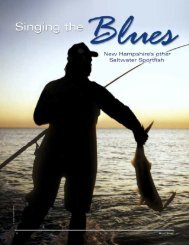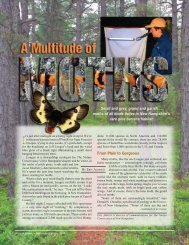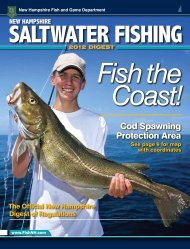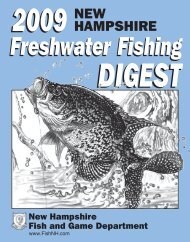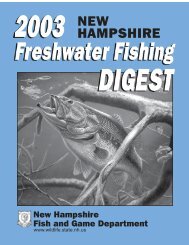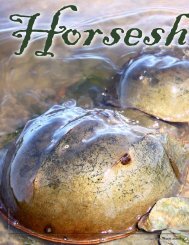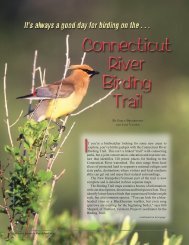In Pursuit of Pike - New Hampshire Fish and Game Department
In Pursuit of Pike - New Hampshire Fish and Game Department
In Pursuit of Pike - New Hampshire Fish and Game Department
You also want an ePaper? Increase the reach of your titles
YUMPU automatically turns print PDFs into web optimized ePapers that Google loves.
prey. Known as “sight predators,” pike have very large eyesthat are focused forward. <strong>Pike</strong> also rely heavily on the “lateralline” — an amazing sensory system that gives them excellentawareness <strong>of</strong> their physical surroundings — to help locateprey. <strong>Pike</strong> have an added advantage to their lateral linesystem: a row <strong>of</strong> tiny pores on the underside <strong>of</strong> the lower jaw.These pores have miniscule hairs inside them that react tovibrations in the water <strong>and</strong> are directly linked with the lateralline system for super sensitivity.<strong>Pike</strong> have a distinctive pattern that will help you distinguishthem from pickerel — light-colored bean shapes over adark background. Also, the pike’s gill plate is only scaled onthe upper half, whereas the chain pickerel’s is fully scaled.With specialized predatory tools including a mouth full <strong>of</strong>knife-edged teeth, the pike is a worthy opponent. Underst<strong>and</strong>ingthese tools is just a part <strong>of</strong> being successful when fishing forpike.Follow the <strong>Fish</strong>Their habitat <strong>and</strong> seasonal location play a vital role incatching pike consistently. <strong>Pike</strong> get an early start on spawning,moving into the backwaters <strong>of</strong> the Connecticut to spawnin late March. They rarely wait for open water <strong>and</strong> will spawnunder the ice. Since these backwater areas are the first to warmup in the spring, many other river fish use these areas forspawning, too. The pike are there, awaiting their arrival.Spring <strong>of</strong>fers the pike a steady diet <strong>of</strong> sunfish, perch, bass,frogs, salam<strong>and</strong>ers — <strong>and</strong> yes, ducklings <strong>and</strong> small mammals.A pike will eat just about anything. But don’t be fooledby the pike’s omnivorous appetite: they can be frustrating tohook.<strong>In</strong> April, the air <strong>and</strong> water temperatures tend to be in the40s. The sun will do its job on the backwaters, warming theseareas <strong>and</strong> bringing the pike onto the feed as the water heats upto 50 degrees or so. Water temperatures are a key factor. Toocold <strong>and</strong> the fish will be sluggish; too warm, the pike moveout.But 50°F is just right, so it’s time for the first trip <strong>of</strong> the yearto the river. My friends <strong>and</strong> I are armed with both spinning <strong>and</strong>fly fishing tackle — imitation baitfish lures <strong>and</strong> flies, a strongspinning rod with ten-pound test line. We’re carrying a sevenweightfly rod with a floating or intermediate line. Both thespinning rod <strong>and</strong> the fly rod get extra protection from thecontinued on next pageWILDLIFE JOURNAL • March/April 2006 5







